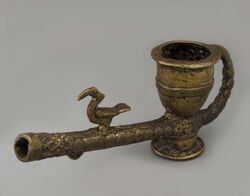Hornbill on the pipe stem
February 2021

Of the headhunters people the Naga, who live in northeast India, we know the wooden pipes decorated with a row of mostly decapitated figures. The pipe bowl shown here comes from the same population, but was made by another sub-tribe, the Kuki. It is an equally characteristic but much rarer Naga piece, from a region that continues in Burma. We see that geographical fact in the design of the pipe. No wood is used in this case, but metal which makes the pipe indestructible. The brass castings show similar characteristics that we see with the Batak in Sumatra and the Lanna in Myanmar. The pipe bowl is made in the lost wax method or cire perdue. An object is sculpted in wax, then packed in clay. That clay is fired at a small fire where the wax melts and runs away. This creates a primitive casting mold that is filled with brass. When that is done, the mantle is smashed and the casting comes out. It is finished and polished. Different styles come together in this pipe bowl. Typically Burmese is the bowl-shaped pipe bowl on a conical base. The square stem with the wonderfully continuous tip that ends with a curl on the rim of the bowl is not known from pipes of other peoples. The stem decoration with fine spirals is also found in other Asian metalwork. Finally, the most characteristic is the sitting bird on the stem. It is the hornbill with its large crooked beak, the so-called Bucerotidae that lives in that area. The date of this piece is rather early, we recognize mid-nineteenth century workmanship.
Amsterdam Pipe Museum APM 24.204
Permalink